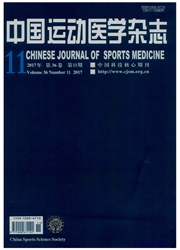

 中文摘要:
中文摘要:
目的:采用三维有限元力学分析法,对比分析前交叉韧带(anterior cruciate ligament,ACL)正常时和缺失后膝关节半月板前角、体部和后角的应力变化。方法:构建并运用胫股关节三维有限元模型,模拟ACL正常时和缺失后膝关节在伸直位、15°和30°屈曲位的运动状态,并在股骨上施加700 N轴向载荷和134 N后向载荷,比较ACL正常时和缺失后内、外侧半月板前角、体部和后角各自的应力分布变化。结果:当ACL缺失后,在膝关节伸直时,内侧半月板前角的应力比正常膝增加100.7%,大于外侧半月板前角的应力增幅(30.7%);在15°和30°屈曲位时,内侧半月板后角的应力分别比正常膝增加36.4%和59.7%,而外侧半月板后角的应力增加不明显;除了外侧半月板体部的应力在膝伸直位比正常膝增加39.5%以外,内、外侧半月板体部的应力变化不明显。结论:ACL缺失对半月板各部分应力的影响并不相同,其主要导致内侧半月板前角和后角的应力分别在膝伸直位和屈曲位显著增加。
 英文摘要:
英文摘要:
Objective To compare the stress distributions on the anterior horn,body part and posterior horn of menisci between the normal and the injured knees with anterior cruciate ligament (ACL) deficiency using the three-dimensional finite element analysis. Methods A three-dimensional finite element model of tibiofemoral joint was created to simulate the motion states of the normal and ACL-deficiency knees at extension,as well as 15° and 30° flexions. Meanwhile,700N axial load and 134N posterior load were applied to the femur. Then, the stress on the anterior horn, body part and posterior horn of medial and lateral menisci were compared between the normal and ACL-deficient knees. Results With ACL deficiency,when stretching the knees straightly,the stress on the anterior horn of medial meniscus increased to 100.7% of the normal knees, bigger than that of the affected lateral meniscus (30.7%). At 15° and 30° flexions,the stress on the posterior horn of the medial meniscus in ACL-deficiency knees increased by 36.4% and 59.7% respectively when compared to normal knees,while the stress on that of the lateral meniscus did not increase significantly. Apart from the stress on the body part of the lateral meniscus increasing by 39.5% at extension in ACL-deficiency knees, no obvious changes were observed in the stress on the body part of the medial and lateral menisci. Conclusion ACL deficiency has different effect on the stress of different parts of the meniscus. It mainly increases the stress on the anterior horn of the medial meniscus at extension and that of the posterior horn of the medial meniscus at flexion.
 同期刊论文项目
同期刊论文项目
 同项目期刊论文
同项目期刊论文
 期刊信息
期刊信息
